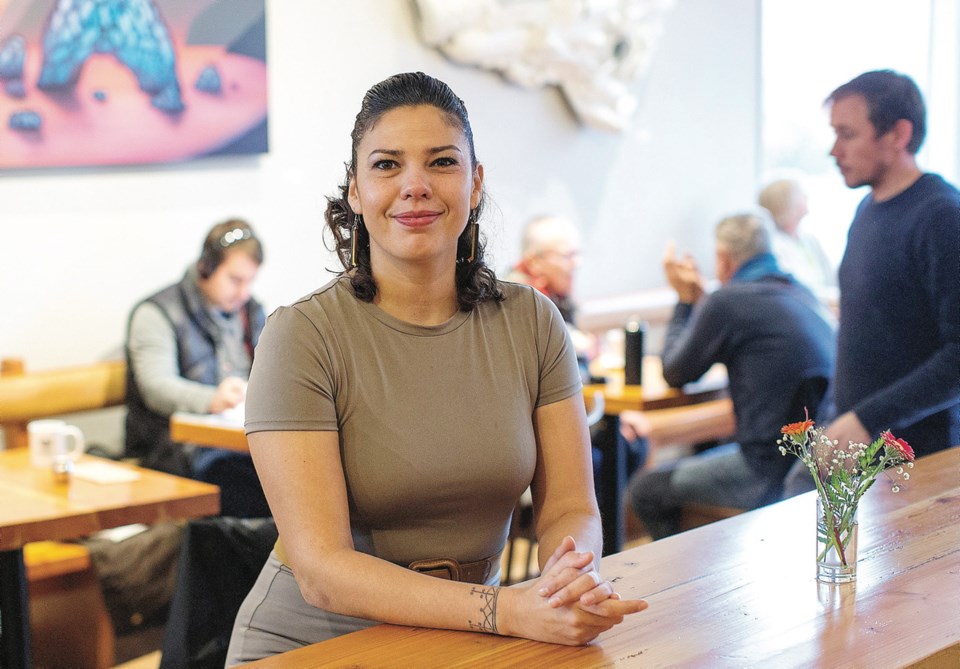What: Performance as Medicine
When: Saturday, 9 a.m. to 5:30 p.m.
Where: Royal B.C. Museum, 675 Belleville Street
Tickets: $15 for workshop, Free for panel and performance
Information: royalbcmuseum.bc.ca
Growing up on a Mohawk reserve just outside Montreal, Lindsay Katsitsakatste Delaronde always knew who she was and where she came from.
“You don’t question your sense of belonging in that environment. Everybody mirrors who you are, where you came from and your family’s connections,” said Delaronde, 33, who was named Victoria’s inaugural Indigenous artist-in-residence this year — which city council declared as a year of reconciliation with First Nations.
“When I started to go off-reserve, I had to look at what it really means to be a Mohawk person and all the ways that’s defined — the legislation, policies and labels. I had to remove that social conditioning and go back to the sensory experience,” said Delaronde, an Iroquois and Mohawk multi-disciplinary artist and educator who uses art and performance as a means of personal and community healing.
“That’s partly why I have this residency. It’s about bringing trust, honesty and holding up community. I’m not doing this alone. It’s a collaborative process that crashes the idea of public art.”
A graduate of the Emily Carr Institute of Art and Design, Delaronde also has masters degrees in fine arts and Indigenous Communities Counseling Psychology from the University of Victoria.
Delaronde will facilitate and take part in Performance as Medicine, a one-day symposium of workshops, performance art and a panel, at the Royal B.C. Museum this weekend with a range of Indigenous artists. The interdisciplinary and intergenerational events explore Indigenous philosophies and contemporary expressive forms. Everyone is welcome, she said.
“Indigenous voices have a lot to give. They remind people they have spirit and a place of origin, with song and story. That’s medicine, the integration of yourself,” she said. “My artwork is about liberating the trapped self.”
Delaronde started her residency with the city amidst personal trauma. Her partner, a recent law school graduate, died from an overdose the same week she got the job.
“It was a very difficult place to be in,” said Delaronde, who used her art and process for healing. Her collaboration with Cheryl Henhawke explored grief and loss through a body-drawing ritual at a public beach in Oak Bay.
One of her first pieces of performance art, We Bring Medicine to the Streets, took place in May at the corner of Pandora Avenue and Amelia Street. The area is frequented by many of the city’s homeless and poor, and those struggling with addictions and mental-health problems.
Delaronde and fellow artist Pascalle Ellefsen harvested and prepared cedar water with which they washed the sidewalk and sang a capella the hymn Precious Memories, inviting people to join in. The reactions from those who participated was a bubbling of emotion, while onlookers were curious about the interruption of space, she said.
“When I did my interview with the city, I said I really wanted to focus on site-specific performance. You have to feel the work. Emotional connection is the power of artwork,” said Delaronde, who described the piece in an artist’s statement as “using old ways of healing and prayer to heal the soul-wound of colonialism.”
Throughout the year, she has also facilitated moccasin-making workshops and a 10-week art program at the Downtown Activity Centre, collaborated on performance-art works with Indigenous and non-Indigenous dancers at the legislature and taken part in numerous discussions and events. All of her performance works have been filmed or photographed and are on her social-media spaces.
“Everything I do comes from visions of the heart and an innate desire to connect,” said Delaronde, who has just over three months left in her residency and would like to continue. The role requires 20 hours of work a week and pays $42,000 for the year, with additional funds for materials. The city’s artist, Luke Ramsey, and Indigenous artists-in-residence are funded by the Art in Public Places Reserve Fund.
“I want to help and be of service through my work. I’ve broken cycles of trauma in my own home and life and would like to help do that for others,” she said.
Video and photos of Delaronde’s work can be found at: facebook.com/IndigenousArtistinResidence/
